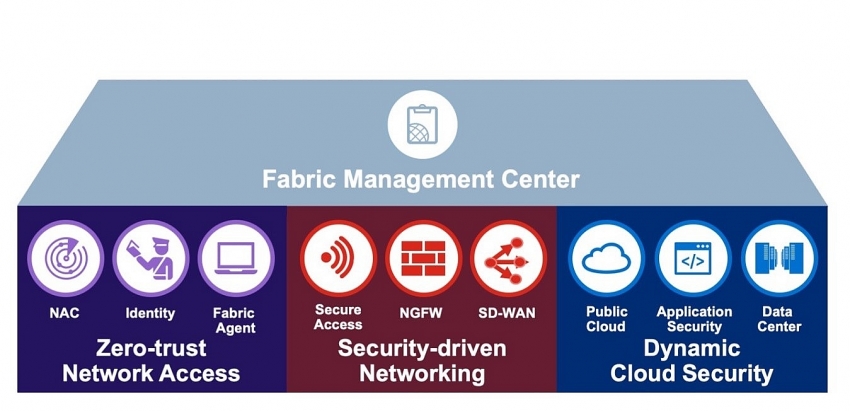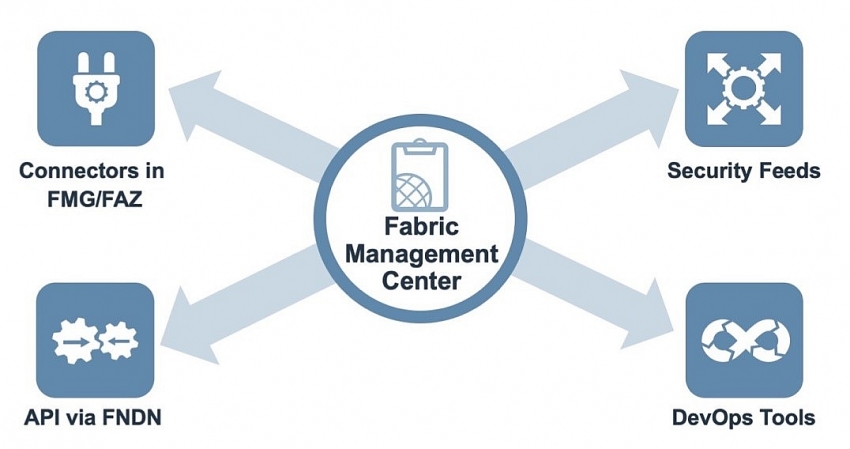Automating network management to accelerate digital transformation
 |
| Fortinet's Fabric Management Center is ready to accelerate digital transformation |
According to a survey by Fortinet, hundreds of customers across segments and industries are facing two major common themes. First, networks are getting more complex with time, and second, automation is a strategic topic of interest regardless of the digital transformation project they have in place.
One of the most critical challenges of these increasingly complex and naturally fragmented infrastructures is how to implement an effective security strategy. Distributed and dynamically evolving networks can be a prime breeding ground for cyber risks, leading to frequent network outages. Contributing to this challenge is the fact that network operations teams rarely have clear and consistent insight into what controls and configurations have been set up across the infrastructure, and more importantly, the lack of comprehensive visibility across the network to identify anomalies. This limited visibility and control is the result of having deployed too many independent point products across the various segments of the network.
The need for network infrastructure automation
The events of the past several weeks, driven by the need to adapt to the COVID-19 pandemic, have accelerated digital transformation for many organisations. In fact, a recent Gartner report on Cool Vendors in Enterprise Networking had some good data points around agile network infrastructures. Notably, digital business requires agile networks, but 70 per cent of enterprise networking activities are performed manually. This creates “human middleware” that limits networking scalability and agility, and increases the likelihood for errors. In addition, the percentage of network activities that will be automated will rise from 30 per cent in early 2020 to 50 per cent by 2023. Furthermore, the percentage of enterprises that do pre-verification of configurations will increase to 10 per cent by 2023, from less than 1 per cent in early 2020.
These data points help explain why 75 per cent of network outages and performance issues are the result of misconfiguration errors.
In this regard, a network security strategy that prioritises network automation can help reduce one of the leading causes of cyber risk and downtime – human error and misconfigurations. An integrated network security architecture enhanced with network automation capabilities can easily eliminate the complexity challenge for network operators.
The Fortinet fabric management centre
Fortinet’s Fabric Management Centre combines FortiManager and FortiAnalyzer for effective network operations, making agile network management a reality for Fortinet customers across NGFW, SD-WAN, and IPS, as well as other projects for the organisation. This combined solution enables three key use cases, namely centralised management, network automation, security fabric analytics.
 |
| The Fabric Management Center offers a plethora of useful features to take work into the digital sphere |
Centralised Management
When it comes to network security, disparate products typically cannot share threat intelligence or co-ordinate responses across an organisational infrastructure. This critical cybersecurity shortcoming is often compounded by a lack of skilled security personnel who are able to manage a wide assortment of disconnected point products. But even large organisations with dedicated IT security staff still have difficulty monitoring the network to keep track of which devices are connected, who has access to the network, and which resources are needed by applications and workflows.
A centralised management solution with a single-pane-of-glass view, such as the one provided by the Fabric Management Centre, enables streamlined visibility that reduces complexity to increase visibility and control. It allows network operations teams to monitor data movement and identify anomalous activity, simplifies solution optimisation, and centralises the management of Fortinet enabled NGFW, SD-WAN, IPS deployments from a single location. It also streamlines operations for limited or under-resourced administrators and staff.
Network automation and orchestration
Automation and orchestration are being increasingly leveraged, especially in enterprises with complex infrastructures. They are used to consolidate configuration and change management for security across complex, hybrid networks – and most importantly, across use cases such as NGFW, SD-WAN, and others.
They are also used by operations teams to actively monitor for anomalies. For example, automation and orchestration can be used to identify irregularities in VPN access in real-time, which is especially critical now that enterprises have had to embrace remote work at an unprecedented scale. This cannot be achieved if security tools have not been properly integrated through a common management framework. The Fabric Management Center enables such automation and orchestration even across complex infrastructures via its built-in connectors and automation hooks, combined with real-time alerts when any network abnormalities are subsequently detected.
Security Fabric Analytics
Achieving real-time network visibility is not an easy task – especially as enterprises add an increasing number of point products to their already complex infrastructures. Once network teams change course by consolidating point products and leveraging FortiOS for IPS, VPN, NGFW, SD-WAN, SD-Branch, and other functions, they can then easily share telemetry data between all deployments and enable real-time visibility of anomalies.
“Fortinet’s Fabric Management Centre enables enterprise-class automation capabilities while helping network leaders actualise industry-leading benefits and improve efficiency. With its single-pane view, FortiManager helps enterprises simplify the oversight of their security infrastructure and automate responses to potential problems,” said Satish Veerapuneni, director of products and solutions, management, analytics and automation, Fortinet.
“Fortinet’s Fabric Management Centre leverages orchestration and automation to increase visibility across complex, hybrid network environments, identify and alert on anomalous behaviour, and ensures granular control to reduce network disruption and downtime, whether they are due to human error or malicious behaviour,” said Satish Veerapuneni.
What the stars mean:
★ Poor ★ ★ Promising ★★★ Good ★★★★ Very good ★★★★★ Exceptional
Themes: Digital Transformation
Related Contents
Latest News
More News
- Acecook Vietnam: 30 years of creating happiness (January 08, 2026 | 08:00)
- Sustainability a core value for DKSH’s vision (January 07, 2026 | 16:00)
- People encouraged to contribute and grow at AstraZeneca Vietnam (January 07, 2026 | 15:48)
- Dat Bike accelerates sustainable mobility (January 07, 2026 | 15:24)
- Innovation to support modern healthcare development (January 07, 2026 | 10:00)
- Six localities record double-digit growth as regional performance diverges in 2025 (January 06, 2026 | 18:00)
- E-commerce market undergoes transformation amid rising competition and regulation (January 06, 2026 | 17:54)
- Vietnam’s industrial output hits seven-year high in 2025 (January 06, 2026 | 17:47)
- GELEX’s credit rating outlook upgraded to 'Positive' by VIS Rating (January 06, 2026 | 16:49)
- Finance sector lays firm groundwork for 2026 after major reform (January 06, 2026 | 15:30)

 Tag:
Tag:

























 Mobile Version
Mobile Version